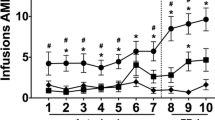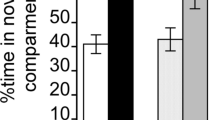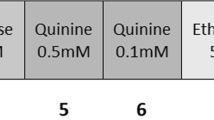Abstract
Rationale
Evidence suggests that differential rearing influences the function of a receptor subtype critical for maintaining glutamate homeostasis. Maintaining homeostatic glutamatergic function may be an important protector against drug abuse.
Objective
This study sought to determine if differential rearing influences the function of a receptor critical for glutamate homeostasis, which could in turn affect rates of amphetamine self-administration.
Methods
Rats were assigned to enriched (EC), isolated (IC), or standard (SC) conditions. After rearing for 30 days, rats were trained to lever press for sucrose reinforcement before the implantation of indwelling jugular catheters. After reaching stable responding for amphetamine (0.03 or 0.1 mg/kg/infusion), rats were injected with five doses (0, 0.3, 1.0, 3.0, and 5.0 mg/kg) of the mGluR5 antagonist, 3-((2-methyl-1,3-thiazol-4-yl)ethynyl) pyridine hydrochloride (MTEP), 30 min before self-administration sessions. Following fixed-ratio (FR-1) testing, rats were administered identical doses of MTEP on a progressive-ratio (PR) reinforcement schedule.
Results
MTEP (3.0 mg/kg) attenuated FR-1 self-administration (0.03 mg/kg/infusion) in IC rats. MTEP also dose-dependently attenuated amphetamine self-administration (0.1 mg/kg/infusion) during FR-1 and PR sessions, with 5.0 mg/kg MTEP attenuating amphetamine self-administration in IC and SC rats and 3.0 mg/kg MTEP attenuating amphetamine self-administration in EC and SC rats. PR results also revealed that IC rats not treated with MTEP were more motivated to self-administer the higher dose of amphetamine.
Conclusions
These results suggest that the mGlu5 receptor mediates differences in drug-taking behavior among differentially reared rats. Isolation also decreased sensitivity to MTEP, suggesting that environmental factors alter glutamate homeostasis which subsequently affects sensitivity and motivation to self-administer amphetamine.






Similar content being viewed by others
References
Alvers KM, Marusich JA, Gipson CD, Beckmann JS, Bardo MT (2012) Environmental enrichment during development decreases intravenous self-administration of methylphenidate at low unit doses in rats. Behav Pharmacol 23:650–657
Arnold JM, Roberts DC (1997) A critique of fixed and progressive ratio schedules used to examine the neural substrates of drug reinforcement. Pharmacol Biochem Behav 57:441–447
Artola A, von Frijtag JC, Fermont PC, Gispen WH, Schrama LH, Kamal A, Spruijt BM (2006) Long-lasting modulation of the induction of LTD and LTP in rat hippocampal CA1 by behavioural stress and environmental enrichment. Eur J Neurosci 23:261–272
Bardo MT, Dwoskin LP (2004) Biological connection between novelty- and drug-seeking motivational systems. Nebr Symp Motiv 50:127–158
Bardo MT, Hammer RP Jr (1991) Autoradiographic localization of dopamine D1 and D2 receptors in rat nucleus accumbens: resistance to differential rearing conditions. Neuroscience 45:281–290
Bardo MT, Klebaur JE, Valone JM, Deaton C (2001) Environmental enrichment decreases intravenous self-administration of amphetamine in female and male rats. Psychopharmacology (Berl) 155:278–284
Beckmann JS, Bardo MT (2011) Environmental enrichment reduces attribution of incentive salience to a food-associated stimulus. Behav Brain Res 226:331–334
Bell SR, Carrillo N (2007) Characteristics of effective summer learning programs in practice. New Dir Youth Dev: 45–63
Bonci A, Bernardi G, Grillner P, Mercuri NB (2003) The dopamine-containing neuron: maestro or simple musician in the orchestra of addiction? Trends Pharmacol Sci 24:172–177
Cain ME, Mersmann MG, Gill MJ, Pittenger ST (2012) Dose dependent effects of differential rearing on amphetamine-induced hyperactivity. Behav Pharmacol 23:744–752
Chiamulera C, Epping-Jordan MP, Zocchi A, Marcon C, Cottiny C, Tacconi S, Corsi M, Orzi F, Conquet F (2001) Reinforcing and locomotor stimulant effects of cocaine are absent in mGluR5 null mutant mice. Nat Neurosci 4:873–874
Corrigall WA, Coen KM, Zhang J, Adamson KL (2001) GABA mechanisms in the pedunculopontine tegmental nucleus influence particular aspects of nicotine self-administration selectively in the rat. Psychopharmacology (Berl) 158:190–197
Council NR (2011) Guide for the care and use of laboratory animals, 8th edn. National Academy Press. Institute of Laboratory Animal Resources, Washington, DC
Darna M, Beckmann JS, Gipson CD, Bardo MT, Dwoskin LP (2015) Effect of environmental enrichment on dopamine and serotonin transporters and glutamate neurotransmission in medial prefrontal and orbitofrontal cortex. Brain Res 1599:115–125
Del Arco A, Gonzalez-Mora JL, Armas VR, Mora F (1999) Amphetamine increases the extracellular concentration of glutamate in striatum of the awake rat: involvement of high affinity transporter mechanisms. Neuropharmacology 38:943–954
Del Arco A, Segovia G, Canales JJ, Garrido P, de Blas M, Garcia-Verdugo JM, Mora F (2007) Environmental enrichment reduces the function of D1 dopamine receptors in the prefrontal cortex of the rat. J Neural Transm 114:43–48
Fone KC, Porkess MV (2008) Behavioural and neurochemical effects of post-weaning social isolation in rodents-relevance to developmental neuropsychiatric disorders. Neurosci Biobehav Rev 32:1087–1102
Garcia KL, Le AD, Tyndale RF (2014) Effect of food training and training dose on nicotine self-administration in rats. Behav Brain Res 274:10–18
Gass JT, Olive MF (2008) Glutamatergic substrates of drug addiction and alcoholism. Biochem Pharmacol 75:218–265
Gass JT, Osborne MP, Watson NL, Brown JL, Olive MF (2009) mGluR5 antagonism attenuates methamphetamine reinforcement and prevents reinstatement of methamphetamine-seeking behavior in rats. Neuropsychopharmacology 34:820–833
Gereau RW, Heinemann SF (1998) Role of protein kinase C phosphorylation in rapid desensitization of metabotropic glutamate receptor 5. Neuron 20:143–151
Gill MJ, Arnold JC, Cain ME (2012) Impact of mGluR5 during amphetamine-induced hyperactivity and conditioned hyperactivity in differentially reared rats. Psychopharmacology (Berl) 221:227–237
Gormley S, Rompre PP (2010) Blockade of mGLUR5 receptors differentially alters amphetamine-induced enhancement of locomotor activity and of brain stimulation reward. J Psychopharmacol 25:393–401
Green EJ, Greenough WT (1986) Altered synaptic transmission in dentate gyrus of rats reared in complex environments: evidence from hippocampal slices maintained in vitro. J Neurophysiol 55:739–750
Green TA, Gehrke BJ, Bardo MT (2002) Environmental enrichment decreases intravenous amphetamine self- administration in rats: dose-response functions for fixed- and progressive-ratio schedules. Psychopharmacology (Berl) 162:373–378
Greenough WT, Black JE, Wallace CS (1987) Experience and brain development. Child Dev 58:539–559
Grimm JW, Osincup D, Wells B, Manaois M, Fyall A, Buse C, Harkness JH (2008) Environmental enrichment attenuates cue-induced reinstatement of sucrose seeking in rats. Behav Pharmacol 19:777–785
Hao Y, Martin-Fardon R, Weiss F (2010) Behavioral and functional evidence of metabotropic glutamate receptor 2/3 and metabotropic glutamate receptor 5 dysregulation in cocaine-escalated rats: factor in the transition to dependence. Biol Psychiatry 68:240–248
Herzig V, Schmidt WJ (2004) Effects of MPEP on locomotion, sensitization and conditioned reward induced by cocaine or morphine. Neuropharmacology 47:973–984
Jay TM (2003) Dopamine: a potential substrate for synaptic plasticity and memory mechanisms. Prog Neurobiol 69:375–390
Jones S, Bonci A (2005) Synaptic plasticity and drug addiction. Curr Opin Pharmacol 5:20–25
Kalivas PW (2009) The glutamate homeostasis hypothesis of addiction. Nat Rev 10:561–572
Kirkpatrick K, Marshall AT, Clarke J, Cain ME (2013) Environmental rearing effects on impulsivity and reward sensitivity. Behav Neurosci 127:712–724
Kupchik YM, Moussawi K, Tang XC, Wang X, Kalivas BC, Kolokithas R, Ogburn KB, Kalivas PW (2012) The effect of N-acetylcysteine in the nucleus accumbens on neurotransmission and relapse to cocaine. Biol Psychiatry 71:978–986
Martin-Fardon R, Baptista MA, Dayas CV, Weiss F (2009) Dissociation of the effects of MTEP [3-[(2-methyl-1,3-thiazol-4-yl)ethynyl]piperidine] on conditioned reinstatement and reinforcement: comparison between cocaine and a conventional reinforcer. J Pharmacol Exp Ther 329:1084–1090
McGeehan AJ, Olive MF (2003) The mGluR5 antagonist MPEP reduces the conditioned rewarding effects of cocaine but not other drugs of abuse. Synapse 47:240–242
Melendez RI, Gregory ML, Bardo MT, Kalivas PW (2004) Impoverished rearing environment alters metabotropic glutamate receptor expression and function in the prefrontal cortex. Neuropsychopharmacology 29:1980–1987
Mitrano DA, Smith Y (2007) Comparative analysis of the subcellular and subsynaptic localization of mGluR1a and mGluR5 metabotropic glutamate receptors in the shell and core of the nucleus accumbens in rat and monkey. J Comp Neurol 500:788–806
Neugebauer NM, Cortright JJ, Sampedro GR, Vezina P (2014) Exposure to nicotine enhances its subsequent self-administration: contribution of nicotine-associated contextual stimuli. Behav Brain Res 260:155–161
Nicola SM, Surmeier J, Malenka RC (2000) Dopaminergic modulation of neuronal excitability in the striatum and nucleus accumbens. Annu Rev Neurosci 23:185–215
Rahman S, Bardo MT (2008) Environmental enrichment increases amphetamine-induced glutamate neurotransmission in the nucleus accumbens: a neurochemical study. Brain Res 1197:40–46
Reid MS, Hsu K Jr, Berger SP (1997) Cocaine and amphetamine preferentially stimulate glutamate release in the limbic system: studies on the involvement of dopamine. Synapse 27:95–105
Renner MJ, Rosenzweig MR (1987) Enriched and impoverished environments: effects on brain and behavior. Springer-Verlag, New York
Richardson NR, Roberts DC (1996) Progressive ratio schedules in drug self-administration studies in rats: a method to evaluate reinforcing efficacy. J Neurosci Methods 66:1–11
Rosenzweig MR, Bennett EL, Hebert M, Morimoto H (1978) Social grouping cannot account for cerebral effects of enriched environments. Brain Res 153:563–576
Ross JT, Corrigall WA, Heidbreder CA, LeSage MG (2007) Effects of the selective dopamine D3 receptor antagonist SB-277011A on the reinforcing effects of nicotine as measured by a progressive-ratio schedule in rats. Eur J Pharmacol 559:173–179
Scofield MD, Kalivas PW (2014) Astrocytic dysfunction and addiction: consequences of impaired glutamate homeostasis. Neuroscientist 20:610–622
Sesack SR, Carr DB, Omelchenko N, Pinto A (2003) Anatomical substrates for glutamate-dopamine interactions: evidence for specificity of connections and extrasynaptic actions. Ann N Y Acad Sci 1003:36–52
Sharp PE, McNaughton BL, Barnes CA (1985) Enhancement of hippocampal field potentials in rats exposed to a novel, complex environment. Brain Res 339:361–365
Simpson J, Kelly JP (2011) The impact of environmental enrichment in laboratory rats-Behavioural and neurochemical aspects. Behav Brain Res 222:246–264
Solinas M, Thiriet N, El Rawas R, Lardeux V, Jaber M (2009) Environmental enrichment during early stages of life reduces the behavioral, neurochemical, and molecular effects of cocaine. Neuropsychopharmacology 34:1102–1111
Stairs DJ, Bardo MT (2009) Neurobehavioral effects of environmental enrichment and drug abuse vulnerability. Pharmacol Biochem Behav 92:377–382
van Praag H, Kempermann G, Gage FH (2000) Neural consequences of environmental enrichment. Nat Rev Neurosci 1:191–198
Vanderschuren LJ, Kalivas PW (2000) Alterations in dopaminergic and glutamatergic transmission in the induction and expression of behavioral sensitization: a critical review of preclinical studies. Psychopharmacology (Berl) 151:99–120
Veeneman MM, Boleij H, Broekhoven MH, Snoeren EM, Guitart Masip M, Cousijn J, Spooren W, Vanderschuren LJ (2011) Dissociable roles of mGlu5 and dopamine receptors in the rewarding and sensitizing properties of morphine and cocaine. Psychopharmacology (Berl) 214:863–876
Wolf ME (1998) The role of excitatory amino acids in behavioral sensitization to psychomotor stimulants. Prog Neurobiol 54:679–720
Wooters TE, Bardo MT, Dwoskin LP, Midde NM, Gomez AM, Mactutus CF, Booze RM, Zhu J (2011) Effect of environmental enrichment on methylphenidate-induced locomotion and dopamine transporter dynamics. Behav Brain Res 219:98–107
Zhu J, Green TA, Bardo MT, Dwoskin LP (2004) Environmental enrichment enhances sensitization to GBR 12935-induced activity and decreases dopamine transporter function in the medial prefrontal cortex. Behav Brain Res 148:107–117
Zhu J, Apparsundaram S, Bardo MT, Dwoskin LP (2005) Environmental enrichment decreases cell surface expression of the dopamine transporter in rat medial prefrontal cortex. J Neurochem 93:1434–1443
Acknowledgments
Research reported in this article was supported by NIH through NIDA grant #: R15DA035435, and Kansas State University. We thank Michele Ulmer, Greg Erickson, Lauren Komer, Emily Reinhardt, Christy Peterson, and Alexander Howard for their assistance in daily experimental procedures, as well as Erik Garcia for providing surgical assistance.
Author information
Authors and Affiliations
Corresponding author
Rights and permissions
About this article
Cite this article
Arndt, D.L., Johns, K.C., Dietz, Z.K. et al. Environmental condition alters amphetamine self-administration: role of the MGluR5 receptor and schedule of reinforcement. Psychopharmacology 232, 3741–3752 (2015). https://doi.org/10.1007/s00213-015-4031-x
Received:
Accepted:
Published:
Issue Date:
DOI: https://doi.org/10.1007/s00213-015-4031-x




